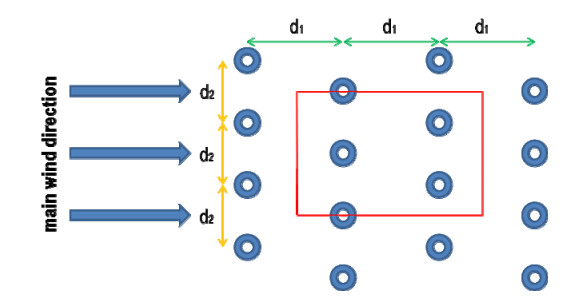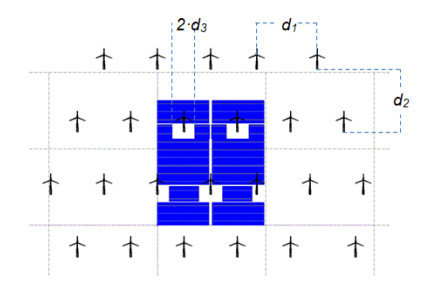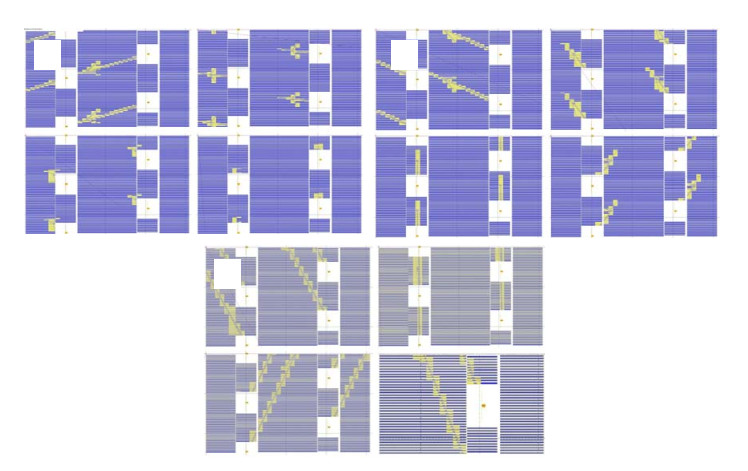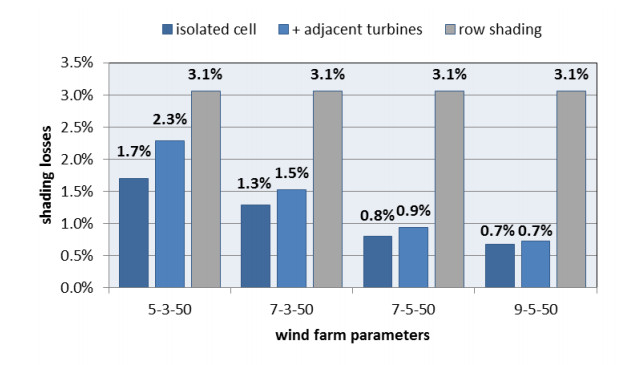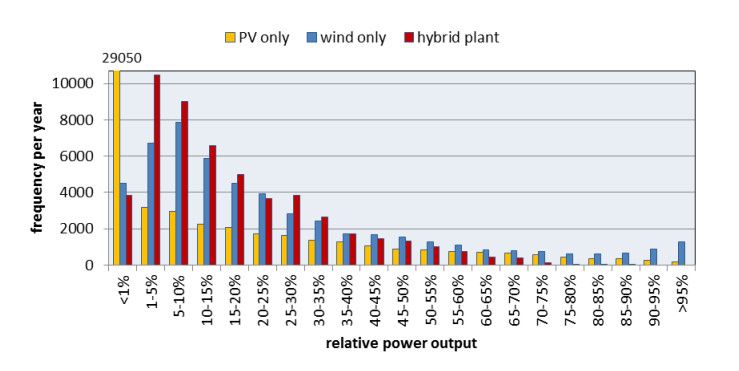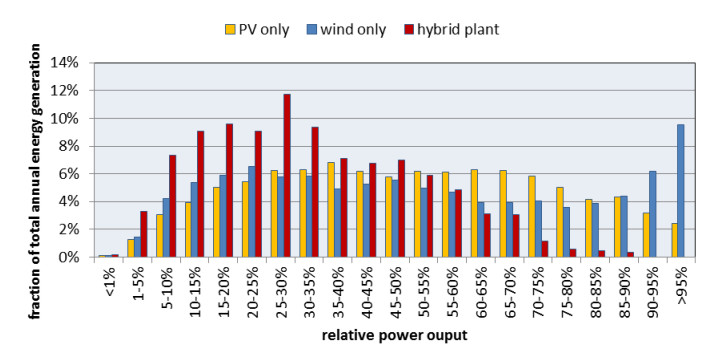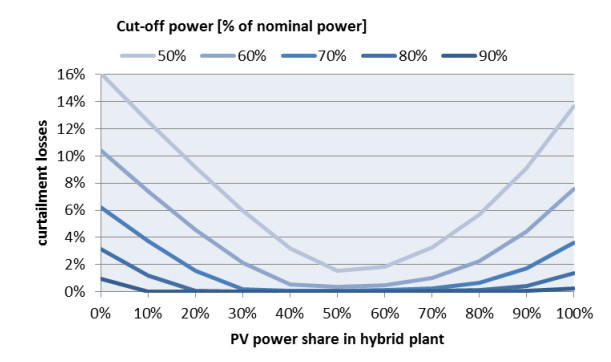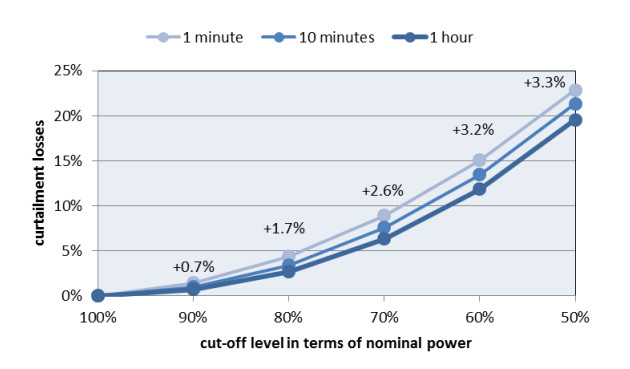This paper examines technical opportunities and challenges of the combination of a wind and solar photovoltaic (PV) power plant to an integrated hybrid plant on the same site. The PV yield loss caused by the wind turbine shading effect is quantified, and the possibility of reducing local grid capacity via the use of a single transmission grid connection. The PV yield loss caused by the shading of wind turbines is quantified for a number of onsite integrated hybrid PV-wind layouts. The corresponding grid connection capacity reduction was also estimated by allowing curtailment when grid connection capacity, which should be lower than the nominal power capacity of the sum of each generator, is exceeded. This finding shows that the PV yield loss due to wind turbine shading was negligible. Even the PV yield loss at the worst case was significantly lower than the regular inter-array shading loss of the specific condition. Hybrid power plants can bring significant advantage over any of the independent PV and wind plants of the same capacity in reducing the grid connection requirement. For a hybrid system, composed of 50% PV and 50% wind capacity, the connecting power line capacity can be as low as 70% of the nominal capacity of the hybrid power plant by allowing a curtailment of approximately 0.07% of the total yield. By comparison, an independent equally sized PV and wind plant could have required a curtailment loss of about 6.2% and 3.6% of the total output, respectively. This is a direct consequence of the effect of both technologies reaching a high electricity generation simultaneously only on few incidences throughout the year. These advantages call for considerations of the effect of complementarity not only during new system design but also to upgrade existing wind plants due to its ability to economically optimise the use of resources.
1.
Introduction
In view of the finite nature of fossil resources used for conventional electricity production, many countries in the world have started to install more and more renewable electricity systems connected to their national electricity grid. The prime example is Germany, where wind, solar, biomass, and other renewables accounted for 36.1% of the total electricity demand in 2017 [1]. This share is expected, and desired, to further increase in the future all around the world [2,3,4,5,6]. The vast cost decline seen especially for solar photovoltaics (PV) in recent years [7,8] supported by the projected increase of fossil fuel prices [9,10] enable an economically viable integration of variable renewable energy (VRE) in the near- to mid-term without incentives [11,12]. This becomes even more inevitable when taking into account the significant extra cost caused by fossil and nuclear energy supply such as climate change mitigation costs, health hazards, subsidized insurance policies for nuclear plants and more [13,14,15,16,17]. However, the variable nature of renewables as compared to the constant production profiles of conventional thermal power plants imposes new requirements on the transmission and distribution system. In particular, the transmission grid has to be dimensioned in a way that allows transporting all electricity regardless of the source being VRE or not. While this enables power delivery even at peak times of solar or wind power generation, it could lead to high investments in the transmission grid capacity burdened by a lower utilisation over the course of the year. Consequently, the increasing challenges for existing grids become visible in Germany already: where its limit is credited for the curtailment of 2.69% of total generated renewable electricity, which is 0.92% of total generated electricity in the year 2017, according to the German Bundesnetzagentur and Bundeskartellamt [18]. 81% of not used renewable electricity was wind onshore, 15% wind offshore, and 3% solar PV electricity.
The most obvious measure to enable the grid to absorb ever increasing amounts of VRE is to expand and reinforce the grid so that even at peak VRE generation times the grid transmission capacity is large enough. This, however, is clearly not the most economical option, as the grid will be over-dimensioned for most of the other non-peak VRE generation times.
Another possibility is to decrease the variability of the solar or wind plants by equipping them with complementing storage infrastructure like batteries (e.g., lithium-ion, sodium-sulphur, etc.) [19,20], other storage technologies or converting the excess electricity onsite to easily storable products, such as methane [21] or hydrogen [22]. However, such options are economically not yet attractive enough in most cases [23,24] for overcoming the variability onsite in a substantial way.
Alternatively, designing a hybrid PV-wind power plant integrated on the same site may provide the opportunity to reduce the grid connection capacity to the transmission network by facilitating a single connection point, and creating the possibility of an optimally sized connection based on the local solar and wind resource complementarity. The natural temporal distribution of the solar and wind resources were credited for the complementarity effect of solar and wind electricity generation [25,26,27,28,29]. This complementarity was reported to increase the power system penetration of VRE at same level of curtailment and without requiring energy storage [26,27], reduce storage and balancing capacity required to achieve a specific high penetration level [27], and improve the reliability of VRE by reducing times of zero generation [26,27,28,29], more than any of the stand-alone versions, i.e., only solar PV or only wind energy. Nevertheless, cost optimised solutions alter the relative share of PV and wind over time [30], strongly driven by relative changes of cost of PV, wind, but also storage and grid solutions, depending on the use cases. The time spread of the combined solar and wind resource not only reduces the number of zero generation times but also the number of times that the transmission grid experiences high electricity generation, compared to very high shares of either solar or wind electricity.
At one specific site, simultaneous maximum solar irradiation and wind speed and the corresponding simultaneous maximum electricity generation only occur for a very limited amount of time during the year [26]. Thus, combining the power produced by PV and wind generators before the electricity is fed into the grid opens up the possibility to cut off the number of times power peaks as compared to the combined nominal capacity of separated generators. This cut off could lead to a substantial decrease in grid capacity that is required to connect an onsite integrated hybrid PV-wind plant as compared to the capacity required for the stand-alone PV or wind power plants. A study examining co-location effects of PV and wind power plants across Europe has identified a reliability improvement through the smoothing effect [31]. Other studies indicate potential economic and resource savings that arise as a result of combining grid connection facilities using single connection points and sharing other resources [32,33,34]. This is especially advantageous when adding solar PV to an existing wind energy plant. Here, costly expansion of the grid for the newly installed PV can be avoided and synergies concerning electrical infrastructure (cabling, grid connection) and land usage in terms of generated electricity per hectare can be created. However, to the author’s knowledge, the magnitude of potential reduction in the transmission grid connection capacity has never been quantified so far. The magnitude of the observed benefits of complementarity also depends on additional factors, particularly on the quality of the local resource. Moreover, most studies focus on system level aspects related to complementarity, such as its role in improving matching to the local demand [26,27], clarifying the characteristics of the resources on its own [28,29], finding an optimal mix of wind and solar [35], as well as the effect of geographic constraints [36,37].
Benefits of the complementarity of wind and solar PV, as discussed above, are also covered with greater detail in [38] but providing little information regarding onsite integrated hybrid PV-wind power plants and respective grid connection. Thus, it is important to perform a comprehensive investigation of the dependence of the onsite hybrid power plant transmission grid connection capacity requirement on complementarity, and the respective losses and its benefits. Although, there is understanding of potential benefits of hybridisation of single plants, there is lack of knowledge about onsite integrated PV-Wind power plants, while the most presently planned systems are systems that involve energy storage or other renewables [32]. There is one known small-scale wind-solar hybrid system in the United States [39]. Onsite integrated hybrid PV-Wind power plants exist in China [34], and they are promoted in India [40,41] and Australia [42,43], but have not yet emerged much in Europe [44]. Two of the largest wind turbine manufacturers support the onsite integration of hybrid PV-Wind power plants [41,42]. The main concern hampering a faster deployment of onsite integrated PV-Wind power plants is the shading of the PV modules by the wind turbines and the resulting losses in PV yield. As a result, this study will also evaluate the effect of shading loss on the onsite integrated hybrid PV-Wind power plant. This study will quantify the required grid connection capacity to access the transmission grid and the corresponding shading loss of the onsite integrated hybrid system by using data for a single site in north-eastern Germany.
2.
Material and methods
The yield losses of the solar PV modules caused by shading effects of the wind turbines were calculated using the PV simulation software PVSyst [45], which is widely accepted for yield analyses and shading simulations of PV power plants. The examined configurations were modelled in detail within the 3D environment of PVSyst. Based on these models, the shading losses were calculated on string-level.
PVSyst calculates the shading losses with an hourly resolution. A matrix of shading factors is created for the direct irradiation depending on the position of the sun. The resolution of this matrix is 20° for the azimuth and 10° for the elevation. Each of these shading factors represents the fraction of the module area that is shaded. However, considering only the module area directly affected by shading disregards the electrical effects that occur on string level when shaded. Therefore, PVSyst offers the possibility to regard each string that is affected by shading as if the whole string was shaded. This worst-case setup was used for this evaluation. In addition to this direct shading factor, the diffuse shading factor is calculated in order to estimate the average diffuse shading of all modules.
Wind turbines differ in several attributes from typical shading objects of PV plants like trees, fences or buildings. They are a lot taller, hence create a shading much further away, and the aspect ratio is different. This leads to many situations where only diffuse shading is present. Also, only the lower part of the tower as well as the gondola can completely shade whole strings while the other parts only shade a few modules of each affected string as is shown in Figure 1. Finally, the rotary movement of the rotor blades creates a unique dynamic shading scenario whose implications will be considered in the theory and calculation section. These characteristics of wind turbines create uncertainties in the calculation of the shading losses. These uncertainties are examined in more detail in the theory and calculation section.
For the analysis of the simultaneous generation of PV and wind and to quantify potential curtailment losses the simulation environment INSEL [46] was used. As compared to PVSyst, INSEL allows the use of smaller time steps and is able to incorporate wind turbines into the model. Generation output of the PV systems and the wind turbines were simulated using the data obtained from two sources. The solar PV simulation was performed using an hourly irradiation data obtained from Reiner Lemoine Institut (RLI), which is based on NASA satellite data processed by the German Aerospace Center (DLR) [47] with an hourly time step for a site near the village Tramm in Mecklenburg-Vorpommern (53.52 N, 11.64 E). The wind turbines output simulation was based on 15 minutes wind data of the Anemos Wind Atlas [48] for the same site. To create the onsite integrated hybrid PV-wind electricity output, the 15 minutes time step for the wind output was averaged to create the corresponding hourly wind generation. The possible inaccuracies that may arise due to some temporal mismatch of the data and the corresponding difference in spatial resolution of the two data sources are assumed to be negligible. The assumed capacity of the onsite integrated hybrid PV-Wind power plant is on the range of approximately 23 MW to 100 MW (Table 1). Details of the system layout and specific assumptions are briefly discussed in the next section.
3.
Theory and calculation
Since the shading of the wind turbines is expected to have a great influence on the yield of the PV array, the layout of the wind park is critical. In theory, the layout of wind parks is only determined by the main wind direction and the economic optimum between maximal nominal wind park power (favouring high spatial turbine densities) and park performance ratio (favouring low turbine densities due to turbulence losses) [49]. However, the layout of real wind parks also depends on existing infrastructure, site boundaries, and terrain contours. To be able to compare the impact of the shading depending on various layout setups, these site specific factors were not considered, i.e., all examined plants are based on the idealized wind park layout. In practice, the distance between the turbines in the main wind direction d1 lies between 5 and 9 rotor diameters, while the distance perpendicular to the main wind direction d2 is between 3 and 5 rotor diameters as shown in Figure 2.
To yield comparable results, an elementary cell with four wind turbines was defined so that it can be repeated indefinitely to form larger wind parks of arbitrary size. The minimum distance between wind turbines and photovoltaic racks d3 was either 50 m or 100 m (Figure 3). The various combinations of these parameters result in the different layouts shown in Table 1. The nominal AC power of these layouts is between 24 MVA and 72 MVA, with a constant nominal wind power of 9.4 MVA assuming four 2.35 MW wind turbines with a rotor diameter of 82 m and a hub height of 100 m.
All layout configurations are first simulated for the isolated elementary cell. However, this disregards shading from wind turbines from one elementary cell on solar modules of another. To quantify this effect the simulations were also conducted for an elementary cell with additional wind turbines placed outside of the cell (Figure 3).
The PV array assumed consists of 240 Wp polycrystalline modules that are installed in two rows of 11 modules per rack in portrait alignment, hence the strings consist of 22 modules across two racks. The pitch between the module rows results in a self-shading angle between rows of 21°. All racks are oriented to the south. There are three vertical and two horizontal maintenance roads. With a width of 12 m these roads are considerably broader than necessary for PV plants to account for additional spacing for cable trenches that would be necessary in practice. The inverters are centralized 675 kVA inverters that are installed in pairs in inverter stations, including one 20 kV transformer.
As stated before, the shading caused by wind turbines implicates certain difficulties for the simulation that are not present in most other cases.
One challenge is the correct evaluation of diffuse shading. It occurs, when—from a solar panel’s point of view—the shading object does not obscure the sun completely and therefore only reduces the direct irradiation. Due to the comparatively small dimensions and the large distance to the solar panels several parts of the wind turbines hardly cast non-diffuse shading and for some, like the tip of the rotor blades, no non-diffuse shading will be cast at all. This leads to a significant overestimation of the shading losses when disregarding the difference between diffuse and direct shading.
The second obvious difference to normal shading objects, such as trees or houses, is the movement of the rotor blades. While this is not accounted for in the simulation due to software limitations, concerns that the fast changing shading of different strings causes the MPP-tracking algorithm to not find a suitable MPP, because of the continuous change in voltage and current, do not apply. First, the diffuse shading, which occurs very often, leads to a significantly smaller shading impact because of the big distances between wind turbine and solar panels, especially for the smaller parts of the rotor blades. Consequently, only minimal variations in current and voltage are assumed to occur. Second, for central inverters with approximately 150 strings per inverter, even alternating shadows on a portion of the module racks do not alter the total number of affected strings per inverter. Therefore, the resulting voltage and current fluctuations at the inverter are small. Third, voltage-regulated MPP trackers are slow in comparison to the movement of the rotor blades [50]. Consequently, a fixed position of the rotor blades can be assumed without introducing significant inaccuracies.
The third uncertainty comes with the way PVSyst calculates the shading losses on a string basis. It simply subtracts the irradiation on the shaded strings from the total irradiation on the module plane. This is satisfyingly accurate to determine shading losses when large shading objects that cast shade on several modules of one string, e.g., row shading or trees, are present. In such cases the string’s electrical behaviour is approximately the same whether half of the modules or all of the modules of one string are shaded. However, the wind turbines, which are more than 50 m away from the module racks, only cast shade on several modules of each string, in many cases even only diffuse shading. In these cases, the impact of the shading on the yield of the plant can be overestimated by more than 40% [51]. As a consequence, PVSyst systematically overestimates the shading losses caused by most parts of the wind turbines, especially the rotor blades. For the 21st of March/September at 10 and 12 o’clock. This overestimation was calculated and quantified to 17% and 15%, respectively.
Combining these three points, it is evident that the additional shading losses by the wind turbines are overestimated in the present analysis. Thus, this result presents the worst case scenario in terms of yield loss.
The analyses for estimating the forced cut-off power to study the impact of connection capacity on curtailment will be simplified as the power lines may be operated on a power level higher than the rated capacity, which will not be considered as a strict limitation.
4.
Results
4.1. PV yield loss due to shading
A qualitative examination of the shading scenes shown in Figure 4 shows the smallest elementary cell (i.e., d1 = 5, d2 = 3, d3 = 50 m) at three different times of the year. The 21st of June represents the day with the least shading, the 21st of December is the day with the most shading and the 21st of September/March represent days with intermediate shading.
Figure 4 clearly shows that in summer there is only a small fraction of the module array shaded by the wind turbines. This also applies for the situation in March/September where the shadows of the wind turbines are somewhat longer, but still only affect a small portion of the array. In December, the shadows of the wind turbines are considerably longer and extend over the whole array. However, at this time of the year, lower strings of each module rack are shaded by the preceding rack and thus the overall yield in this month is relatively low. This means that despite the high shading by the wind turbines in winter, the overall yield loss during this time is relatively low compared to the annual yield of the PV plant.
Figure 5 displays the quantitative results for the shading losses for different layout sizes for east-west orientation with and without the influence of turbines from neighbouring cells.
Surprisingly, the 3.1% self-shading of the PV array is considerably higher than the shading effect of the wind turbines even for the smallest layout with surrounding turbines, where the additional shading caused by the wind turbines is only 2.3%. For the largest plant layout, with larger distances between the wind turbines, the additional shading is only 0.7%. These values are even lower for the single cell with no additional wind turbines around.
It is important to note that the higher the self-shading losses are, the lower the additional losses caused by the wind turbines become. This is because with higher self-shading, the shade of the wind turbines is more likely to hit modules that are already shaded by the module racks in front of them. As the self-shading angle of 21° is rather low, the additional losses caused by the wind turbines are likely to decrease for many projects with higher self-shading angles.
To assess the influence of the main wind direction and the corresponding rotation of the layout. Some layouts were modelled with north-south and east-west orientation. The east-west orientation always yields higher losses than the north-south orientation. This is because the sun has its highest elevation at noon, causing considerably shorter shadows to the north than in the morning/afternoon when shadows with west-east direction are much longer. The additional shading losses for east-west layouts vary between 0.05% and 0.45% with respect to north-south layouts depending on the spacing between the wind turbines.
4.2. Effect of solar-wind complementarity on grid connection capacity
The forgoing results show that the PV yield loss caused by wind turbines in an onsite co-located hybrid PV-wind system is significantly lower than the loss that may arise due to inter-array shading of PV modules. On the other hand, the complementarity of these resources may bring some techno-economic benefit to the onsite integrated hybrid PV-Wind power plant as compared to its separated stand-alone alternative. While local grids may partly be benefitting from the effect of their complementarity, both technologies are almost never combined into one plant using the same grid connection. This results in grids that are locally oversized due to the full consideration of both generation capacities while bringing the overlaying extra high voltage grids to their thermal limit at the few instances with maximum load. The following analysis of the temporal availability of both technologies elaborates the synergies of a combined approach that may bring added benefit to the owner of the power plant and the utilities.
Figure 6 shows the frequency distribution of PV, wind and a hybrid PV-wind power plant output over a year. The hybrid plant corresponds to the 5-3-50 configuration (in terms of d1-d2-d3) and consists of approximately 70% PV and 30% wind energy (see Table 1). It is evident that the single independent technologies are in a state of high generation considerably more often than the combined plant. At the same time, it can be seen that the state of very low generation (<1% the nominal power capacity) is also higher for the independent technologies, especially for PV, as compared to the hybrid power plant.
The significance of the different load states becomes even more evident when looking at the energy yield rather than the frequency. Figure 7 shows the fraction of the annual energy yield for the three power plants that is produced at different power output values. Both the pure PV and wind plants generate approximately half of their yearly energy at plant utilisations above 50%. The combined plant, however, generates a big portion of the yearly yield below 50% utilisation and less than 3% above 70%, which is the same as PV nominal capacity. This is a direct consequence of the fact that both technologies simultaneously run at high loads only on the few incidences of midday hours on clear summer days with wind speeds above the rated wind speed of the deployed turbine.
The curtailment losses for different plant configurations are shown in Figure 8 as a function of cut-off power. For a hybrid plant with equal shares of PV and wind (in terms of nominal power) even a cut-off at 70% of the plant generation capacity results in only 0.07% curtailment losses while pure wind and PV plants suffer losses of 6.2% and 3.6%, respectively. This illustrates the advantage of a combined approach due to the diversification of resources when it comes to limiting the output power of the plant. Care should be taken, however, when considering the exact numbers. They strongly depend on the specific wind and irradiation profiles over the year and can thus vary significantly for different locations.
When calculating curtailment losses, it is very important to evaluate the influence of the considered time resolution. At a low resolution, the measured data present an average over the corresponding long time step, thus levelling any power peaks that may occur for shorter times. Consequently, curtailment losses are underestimated.
To determine the influence of the time step size highly resolved irradiation data were acquired from the German Meteorological Service (DWD) reference climate measurement station in Potsdam in 2011. The irradiation data have a time step of 1 minute. For the analysis the 1-minute data was averaged to give additional data sets with 10-minute time resolution and 1-hour time resolution. Based on this data the curtailment losses of a pure PV plant were evaluated to determine the margin of error when using hourly data. The results are shown in Figure 9. The additional losses strongly depend on the size of the time step and the cut-off power. When comparing this additional term to the original losses for the 1-hour data set, the dependence on the cut-off level is even more dramatic. At 90% cut-off level, the additional 0.7% losses for the 1-minute data is of comparable size to the 1-hour losses. Similarly, at the 70% cut-off level the additional losses (2.6%) are less than half of the original 1-hour losses (6.4%).
Despite this difference observed in relation to irradiation data with 1-minute and 1-hour time steps, the qualitative result of the calculations regarding the curtailment losses for a hybrid plant compared to pure wind or PV plants stays the same. The curtailment losses are much lower when combining both technologies. In summary, in order to find the exact estimate and hence to generate a reliable statement about the economic feasibility of limiting the power output of a hybrid plant a number of parameters have to be taken into account. For example, the exact location with corresponding data sets on wind speed and irradiation, sufficiently high time resolution of the data sets, the PV/wind share of the plant, and the cut-off level, are important parameters. For the specific examples discussed in this paper, the expected curtailment losses were calculated to be 0.07% for a cut-off level of 70% and a PV-wind nominal power share of 50%. Even though this number will be underestimated due to the low time resolution, it is expected not to rise to more than approximately 0.2%.
In conclusion, using an onsite integrated hybrid PV-wind power plant, the size of the grid connection can be reduced or the installed generation capacity can be increased. This can be achieved with only minimal curtailment losses that can occur in a few times of a year when both technologies operate at maximum load. This becomes especially significant when it is possible to operate with a medium voltage interconnection point for the hybrid system instead of a high voltage interconnection point with independent PV and wind plants of comparable size.
5.
Discussion
Several studies examine ways of addressing the challenge that comes with the variability of wind and solar resources. Some investigated the roles of storage and curtailment [52,53] to increase its use while other studies evaluated ways of using hybrid generation resources by enhancing the complement from dispatchable renewable resources, such as hydropower [54,55] and bioenergy [56]. The potential role of wind-solar complementarity is also a subject of several studies [25,26,27,28,29,30,38]. It is shown in literature that wind and PV are generally expected to complement each other on a local level, resulting in very few instances where both technologies simultaneously have high electricity generation [25,26,27,28,29,30]. The quantitative effect, however, can be very different from one location to another even if identical system configurations are considered because it depends on the exact local wind speed and solar irradiation profiles as well as other environmental factors. In the state of New York [35], California [27], Texas [28], Europe [31], the entire United States [36] and Israel [26] a hybrid PV and wind plant was indeed found to be favourable compared to PV-only or wind-only systems, though the lessons may not directly imply similar effects at the level of onsite integration. Contrary to that in Northern Chile the benefit of hybridisation of PV with wind was found to be limited due to the fact that there, the wind resource is connected to solar irradiation in the form of thermal up winds [37]. This paper presents the potential benefits of onsite PV-wind complementarity that was not quantified before. The study shows that combining PV and wind systems on a single site brings the opportunity to reduce the required grid connection capacity by up to 30% of the nominal capacity of the hybrid system, while associated curtailment losses remain on a low level. The quantified additional losses induced by wind turbines shading on PV modules have also been very low, if respective minimum distances between PV modules and the wind turbine towers are taken into account.
Besides the technological synergies regarding the grid connection, a combination of both technologies into one plant offers various economic advantages [32,33]. One of the major advantages of combining both technologies and of upgrading one existing plant with the other technology is the usage of the same grid connection. Especially when the possible grid connection point is not directly accessible on site, the costs of the grid connection can reach as much as 10–20% of the overall costs of the plant. The possibility to split these costs between project partners or to distribute the same costs over considerably higher total generation capacity has the potential to lower the specific grid costs significantly. Other factors are shared costs of project development as well as infrastructure such as maintenance roads. Also, when upgrading an existing wind or PV power plant with the other technology it might be possible to re-use the already existing grid connection infrastructure. In a study performed in Australia, it was estimated that the onsite integrated hybrid PV-wind power plant reduces both the capital and operational expenditures of the power plant [33] through the reduction of costs related to grid connection facilities and installations as well as that of operation, maintenance and development. The estimated cost reduction is found to be in the range of 3%–13% for the capital expenditures and 3%–16% of the annual operational expenditures.
Another advantage of combined PV and wind energy plants is a significant increase of land usage efficiency, an important factor when land area for renewable power production is limited. Today wind farms can be combined with biomass usage of the land between the turbines. However, the energetic yield of a hybrid PV-wind power plant is a lot higher as compared to the high land use requirement for a low photosynthesis efficiency of growing biomass for electricity generation, independently whether via biomass-to-power [5] or biomass-to-biomethane-to-power [21].
Nevertheless, technological and operational complementarity, which leads to cost reductions in the scale of 5–20%, may not be enough, particularly in cases where cost of one technology relatively declines very fast, as it has been documented in the past and is expected to continue as a result of further technological progress of solar PV and batteries [7]. The relative contribution of wind energy to least cost solutions for 100% VRE supply is found to steadily decrease [30], since low-cost solar PV is strongly enabled by batteries and electrolysers than higher cost wind energy, thus leading to higher solar PV electricity shares in least cost solutions. A next more pronounced future development may be an additional onsite battery storage integration for onsite hybrid PV-wind power plants, as built in 2020 in South Korea [57].
6.
Conclusions
In this paper, we analysed the possibility of combining onsite a PV plant with a wind farm to form a hybrid renewable power plant and examined the expected advantages and disadvantages for a site in northeastern Germany.
In particular, we quantified the additional expected shading losses the PV modules would suffer in such an arrangement due to the wind turbines onsite integration. These losses turned out to be surprisingly low. Even for very unfavourable configurations with densely packed wind turbines, the shading losses did not exceed 2.3%, which is still significantly lower than the 3.1% shading losses that occurs due to the self-shading of the solar PV module rows. This number is a worst case estimation, primarily due to the fact that partly shaded solar module strings were considered as completely shaded and the nature of diffuse shading was disregarded by the used software.
Despite the losses, onsite co-locating hybrid PV-wind power plants was found to carry an advantage over the stand-alone PV and wind systems due to resource complementarity. The main advantage of such a configuration relates to the possibility of utilising the grid connection facilities to the transmission grid in a much more efficient way than would be possible otherwise. For the specific location, the available data shows that limiting the connecting transmission line capacity to 70% of the nominal power capacity of the onsite integrated hybrid PV-Wind power plant and assuming equal power capacity shares for PV and wind will lead to a curtailment of only 0.07% of the total yield while alleviating the prerequisites for the size of the grid connection facilities. By comparison, the corresponding curtailment loss of the independent plants would have been 6.2% and 3.6% for wind and PV power plant output, respectively. The corresponding loss was estimated to remain below 0.2% of the annual yield even when the expected underestimation of the loss that may occur due to the use of low time resolution data is accounted for. Especially the possible saving in terms of logistics and the costs of larger projects may be higher for remote projects with high voltage connection as compared to connections with a medium voltage. Other studies also agree on the possibility of such savings for other locations on other continents and for different climates. However, the magnitude of the benefit may depend on various factors related to specific case.
Finally, this concept should be given due consideration not only when designing a hybrid plant from scratch but also to upgrade existing wind farms by adding PV or vice versa in areas, particularly in places where the grid capacity has already experienced congestions or land designated for wind or PV project is scarce. The land use in terms of electricity yield per area is a lot higher with the presented concept than when combining e.g., wind with biomass.
Conflict of interest
The authors declare no conflict of interest.
Acknowledgements
The authors would like to thank Markus Zerer and Volker Quaschning for support and valuable discussions.
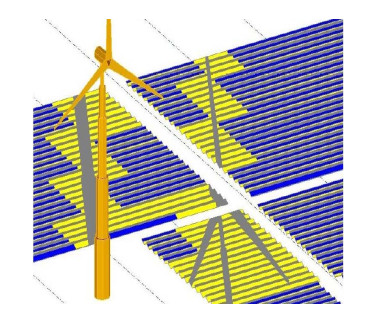









 DownLoad:
DownLoad:
